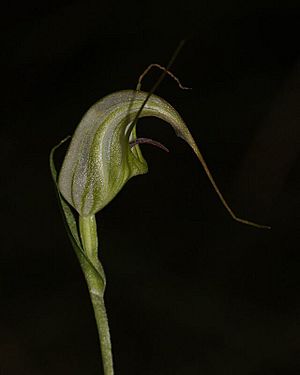Pterostylis tenuissima facts for kids
Quick facts for kids Swamp greenhood |
|
|---|---|
 |
|
| Conservation status | |
| Scientific classification | |
| Genus: |
Pterostylis
|
| Species: |
tenuissima
|
| Synonyms | |
|
Diplodium tenuissimum (Nicholls) D.L.Jones & M.A.Clem. |
|
The swamp greenhood (Pterostylis tenuissima) is a special type of orchid that grows only in the southern parts of mainland Australia. Like other greenhood orchids, it looks different depending on whether it's flowering or not. When it's not flowering, it has a group of leaves that lie flat on the ground. But when it's ready to bloom, a single flower grows on a stem with leaves along it. This greenhood has small, see-through white flowers with dark green stripes. Its top and side parts of the flower have long, thin, thread-like tips.
Contents
What Does the Swamp Greenhood Look Like?
The swamp greenhood is a plant that grows from an underground tuber (like a small potato). It's a perennial plant, meaning it lives for more than two years. It's also deciduous, so some parts die back each year, and it's a herb, meaning it doesn't have a woody stem like a tree.
Leaves and Stems
When the swamp greenhood is not flowering, it has a group of egg-shaped leaves called a rosette. These leaves lie flat on the ground. Each leaf is about 3 to 20 mm (0.1 to 0.8 inches) long and 2 to 7 mm (0.08 to 0.3 inches) wide.
When the plant is ready to flower, it grows a single flower on a stem. This stem can be 100 to 300 mm (4 to 12 inches) tall. It has between three and seven leaves growing along the stem itself.
The Flower
The flowers are about 12 to 15 mm (0.5 to 0.6 inches) long and 6 to 8 mm (0.2 to 0.3 inches) wide. They are a translucent (see-through) white color with dark green stripes and markings.
The top part of the flower, called the dorsal sepal, and the petals are joined together. They form a hood, or "galea," which covers the central part of the flower called the column. The dorsal sepal curves forward and down, ending in a thin, thread-like tip that is 10 to 15 mm (0.4 to 0.6 inches) long.
The side parts of the flower, called the lateral sepals, are held close to the galea. They also have long, thread-like tips that stand upright, measuring about 20 to 25 mm (0.8 to 1 inch) long. The space between these lateral sepals, called the sinus, bulges forward and has a V-shaped notch in the middle.
The "lip" of the flower, known as the labellum, is dark brown and slightly curved. It's about 6 to 8 mm (0.2 to 0.3 inches) long and 2 mm (0.08 inches) wide. This labellum sticks out above the sinus.
Swamp greenhoods usually flower from October to February.
How it Got its Name
The swamp greenhood was first officially described in 1950 by a person named William Nicholls. He found a sample of the plant near a place called Nelson. The description was then published in a science magazine called The Victorian Naturalist.
The scientific name for the species, tenuissima, comes from a Latin word, tenuis, which means "thin." The word tenuissima is the "superlative" form, meaning "thinnest." So, its name basically means "the thinnest Pterostylis."
Where the Swamp Greenhood Lives
The swamp greenhood grows in the very south-eastern part of South Australia and the south-western part of Victoria. There's also a separate group of them (a disjunct population) living on Wilsons Promontory.
These orchids like to grow in muddy, swampy areas. You can often find them under thick groups of woolly tea-tree (Leptospermum lanigerum) and scented paperbark (Melaleuca squarrosa). Sometimes, they even form large groups or colonies in these places.
Protecting the Swamp Greenhood
The swamp greenhood is considered "vulnerable." This means it's at risk of becoming endangered if we don't protect it. It's listed as vulnerable under important Australian laws like the Environment Protection and Biodiversity Conservation Act 1999 and the Victorian Government's Flora and Fauna Guarantee Act 1988.
Some of the main dangers to the swamp greenhood include:
- Land clearing: When land where they grow is cleared for other uses.
- Grazing by livestock: Animals like cows eating the plants.
- Draining of wetlands: When the swampy areas they need are dried out.
- Weed invasion: When other plants (weeds) grow too much and take over their habitat.


